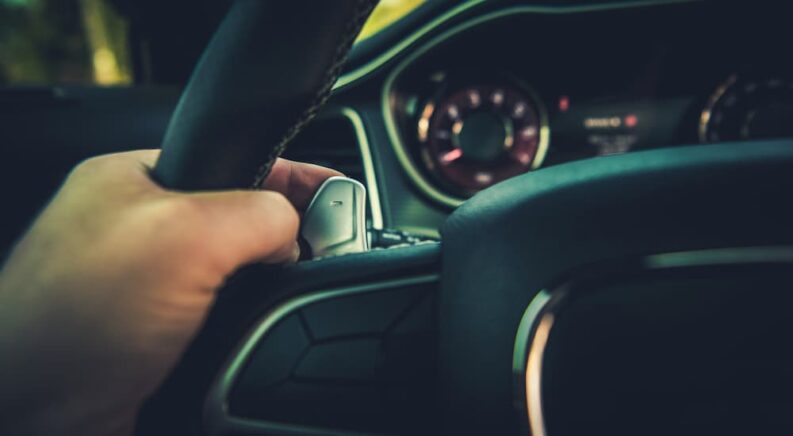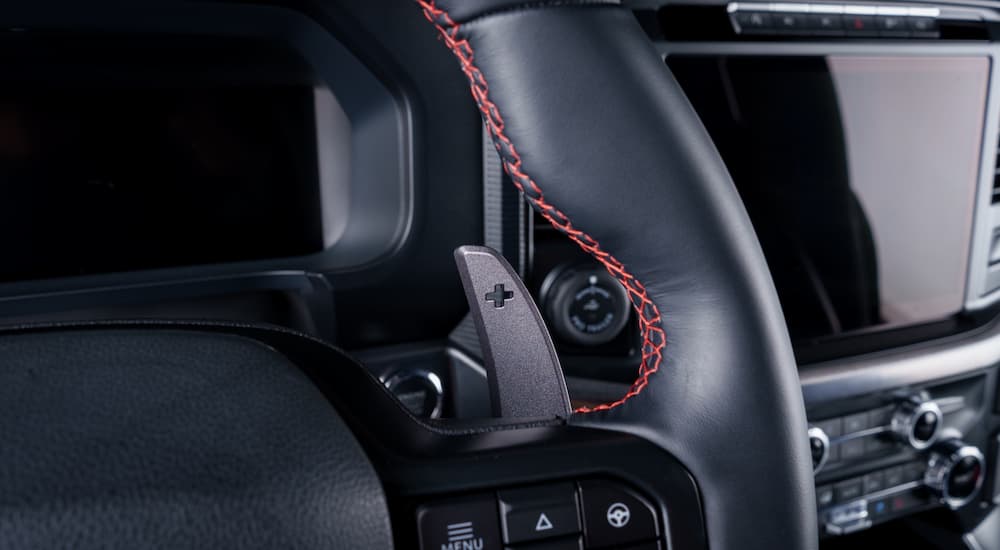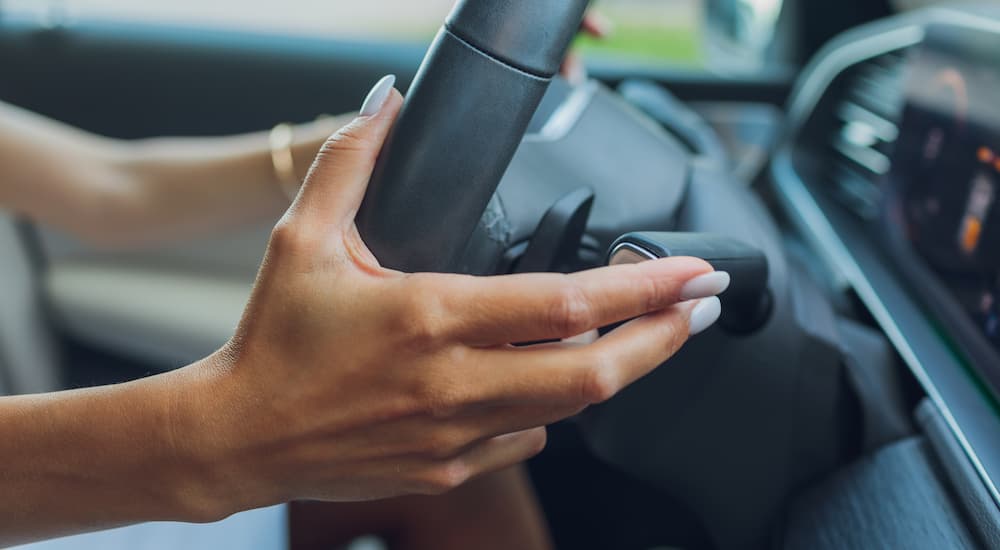Imagine yourself in the driver’s seat, cruising down a winding mountain road. A sharp curve is approaching, but you’re more than prepared to handle it. Effortlessly, you reach behind the steering wheel with your left hand and pull the paddle toward you. There’s a light, satisfying click as the transmission downshifts, and your RPMs begin to rise. The engine helps reduce speed as you enter the turn. You pull the paddle toward you once more as your right foot mashes the accelerator closer to the floor, and you glide through the corner, smooth as butter. There’s no clunky shift lever or bulky clutch pedal, just pure uninterrupted connection between man (or woman) and machine. That’s the power of the paddle shifter in action.
Meet the Paddles
Paddle shifters are small levers mounted either on the back of the steering wheel or on the steering column. The paddle on the right is normally marked with a “+” for upshifting, and the one on the left with a “-” for downshifting. They allow drivers to control gear changes in automatic and semi-automatic transmissions without the use of a clutch pedal. They don’t require the driver to take their hands off the wheel or their eyes off the road, even for a second. They were born for motorsport, but over the last couple of decades, they have been creeping into more production vehicles.
The origin of paddle shifters can be traced as far back as 1912, when Amede Bollee created a ring-based shifter that allowed drivers to shift gears without using a clutch. It would be several decades before the concept caught any traction, but thanks to the Ferrari F1-89 Formula 1 car, paddles became a staple in motorsports by the 1990s. Ferrari is also credited with the introduction of paddles to production cars with their 1997 F355 F1. From there, they blossomed into use by many other high-end manufacturers like Porsche, BMW, and Alfa Romeo. They have since been adopted by more common models like the Nissan Z car and even some trim levels of the Toyota Camry.
Mechanics or Magic?
Paddle shifters function by utilizing electronic or electro-hydraulic signals that communicate with the transmission control module (TCM). When you pull a paddle, those signals tell the TCM to shift either up or down. This temporarily overrides the transmission’s automatic function and gives the driver control over gear selection.
Most setups require the selection of a manual or “sport” mode before the paddle shifters become active. This safeguards the drivetrain by preventing the paddles from being engaged accidentally. Transmissions typically compatible with a paddle shifter format include traditional torque converter automatics, dual-clutch systems (DCTs), and even some CVTs equipped with simulated gear setups.
Is there any real benefit, or is this all just for the sake of change? Paddle shifters offer advantages for nearly everyone, from the daily commuter to the weekend warrior to Michael Schumacher. Here’s what they bring to the table.
- Greater control: Being able to choose when to upshift or downshift allows you to balance power and efficiency more effectively. If you need more torque for passing, you’ve got it. If you’re trying to maximize fuel economy, shifting a little earlier is in the cards. You make the decisions.
- Smoother and faster shifts: This means smoother, faster corners, and not taking your hands off the wheel to achieve them is more than ideal in most situations. We’ll count that as another win for both safety and performance.
- Engine Braking: If you’re like me and want to save your brake pads and, ultimately, your money, engine braking is a great tool. It allows the engine to help in slowing the car on steep declines or when approaching a stop. This effectively reduces wear on your braking system and wallet.
- Towing and Slippery Conditions: Sometimes, things change, and our cars don’t always know it. If it’s slushy out, you may want to start in a higher gear to avoid wheel spin. If you’re towing something on the heavy side, you may want to stay in a lower gear than your transmission would normally think.
- System Safety: Paddle shift systems generally protect themselves from disaster. Mistakes like overrevving or a poorly executed downshift, which would usually cause incredible amounts of damage, are anticipated and safeguarded against. This ensures that the transmission’s life will hold up to the rest of the vehicle.
Confidence in the Click
Use of the paddle shifters may be intimidating at first, but the process couldn’t be much easier. First, and most importantly, you’ll need to engage the manual or sport mode of the vehicle. It’s also important to familiarize yourself with the controls. You should be able to feel when to upshift, with the improved connection and all, but if you find yourself searching, a solid shift point would be around 2,500 to 3,000 RPM.
Downshifting comes with the corners, hills, and any chance you get to overtake the car you’re following. The largest part of using paddle shifters is simply to practice. It’s a different feel than a traditional manual transmission and takes some getting used to. Don’t let a couple of bad shifts get in the way of enjoying the open road. You’ll get it in the next curve.
Paddle shifters are more than just a cool motorsport accessory or a fun shifting alternative. They’re practical as well. Let’s look at some real-world situations where it may be useful to have a paddle.
- Highway passing: When you’re passing slower traffic on the highway, it usually needs to be done quickly. The ability to anticipate the downshift and gain instant torque for acceleration before you need it is priceless and can ultimately make the vehicle safer to drive.
- Hills: Steep declines often demand a lot out of our brakes. When done correctly, engine braking can save you a lot of wear and tear by keeping your foot off the brake pedal.
- Twisty turns: Smooth transitions can make or break a vehicle’s stability. Track day instructors teach you not to shift in a corner, but the lightning-fast gear changes of a transmission with paddle shifters can transform a clunky and potentially dangerous experience into more acceleration out of a corner than a stick shift can safely provide.
- Towing: Hauling a heavy load can strain an automatic transmission. It constantly hunts for the right gear it needs to be in as the terrain changes, which often leads to overheating and catastrophic failures. Paddle shifters enable easy manual control that eliminates gear hunting and overheating so you can be in it for the long haul.
If you enjoy being “one with your car,” or if you find yourself looking for a little bit more control in certain situations, paddle shifters might be something you want to explore further. Conversely, if you spend most of your time behind the wheel stuck in stop-and-go traffic, it may be easier just to let the automatic do its own thing, and that’s completely fine.
No matter your driving style, paddle shifters can benefit you. There’s a reason that they use them in racecars, but there are just as many reasons that they have been brought into production. If used properly, paddles won’t damage your vehicle or its transmission, so what’s the harm in giving them a try?
Paddle Up and Hang On Tight
Paddle shifters offer a mix of convenience and control. The racing pedigree gives us more connection to the machine, while the more mainstream production aspects provide us with a little more practicality. At first glance, paddles may seem like a novelty or a gimmick, but their benefits and advantages are becoming very tangible.
Change can be a little unsettling sometimes, but it’s not always bad. The next time you’re behind a wheel equipped with paddles, whether that’s your daily driver or a rental, don’t hesitate to switch it over into sport mode and give it a try. You may be surprised by how much of a burden that old clutch has been all these years.






